Our Even Paladin deck list guide for the Rastakhan’s Rumble expansion features one of the top lists for this archetype. This Paladin guide includes Mulligan Strategy, Gameplay Tips, Card Substitutions, and Combos/Synergies!
Introduction
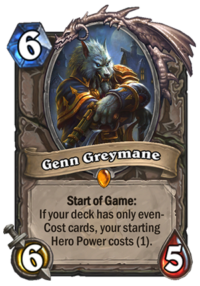
Even Paladin was first created in The Witchwood, and it quickly started to dominate the meta. It had enough tempo and defensive plays to withstand the aggression of faster decks, as well as enough pressure and ways to refill the board to fight versus slower builds. One of the main sources of the deck’s power was Call to Arms, a 4 mana spell printed in Kobolds & Catacombs. Given that the deck played no 1 mana cards, it always pulled out three 2-drops, making it already 6 mana of on-board tempo (even though you’ve only paid four). If you combine that with the fact that it increased the quality of your future draws (there were less small cards in your deck left), as well as synergies (Knife Juggler, Sunkeeper Tarim), the end result was insane. Getting a Turn 4 Call to Arms was often a game-winning.
But then, the card was nerfed, and so Even Paladin fell out of favor. Not only the the deck’s most powerful card was no longer playable, but players didn’t really have another great 4-drop to put in that slot (not to mention that there was no longer a reason to play so many 2-drops, given that you couldn’t pull up to 6 of them from your deck). Odd Paladin has started seeing more and more play in its place, and it was the dominating Paladin deck ever since.
But more recently, after the Boomsday Project nerf-patch, Even Paladin is starting to get some traction again. While it didn’t get many strong tools in the latest expansion, all the meta shifts have put it in a favorable position. It has positive matchup against majority of the meta, with only a bunch of removal-heavy decks being able to beat it consistently.
Table of Contents
Even Paladin Deck List
- 0Even Paladin Deck List Guide – Rastakhan’s Rumble – March 20191
- 0Even Paladin Deck List Guide – Rastakhan’s Rumble – March 20191
- 0Even Paladin Deck List Guide – Rastakhan’s Rumble – March 20191
- 0Even Paladin Deck List Guide – Rastakhan’s Rumble – March 20192
- 0Even Paladin Deck List Guide – Rastakhan’s Rumble – March 20192
- 0Even Paladin Deck List Guide – Rastakhan’s Rumble – March 20192
- 0Even Paladin Deck List Guide – Rastakhan’s Rumble – March 20192
- 0Even Paladin Deck List Guide – Rastakhan’s Rumble – March 20192
- 0Even Paladin Deck List Guide – Rastakhan’s Rumble – March 20192
- 0Even Paladin Deck List Guide – Rastakhan’s Rumble – March 20192
- 2Crystalsmith Kangor1

- 2Hydrologist2

- 4The Glass Knight1

- 6Avenging Wrath1

- 6Sunkeeper Tarim1

- 6Val’anyr1

Find more versions of this deck type on our Even Paladin archetype page!
Mulligan Guide and Strategy
Higher Priority (Keep every time)

- 2-drops – Hydrologist, Argent Protector, Amani Berserker, Acidic Swamp Ooze – Turn 2 play is probably the most important one in this deck and you absolutely want to have at least a single 2-drop, but ideally two of them. Since the deck has no 3-drops either, if you don’t have a 2-drop, you will have to Hero Power up until Turn 4, and that’s floating a lot of mana. Those three cards are your best 2-drops – Hydrologist is always a solid T2 play, Argent Protector should have a target if you open with a T1 Hero Power (basically turning it into an Argent Squire), while Amani Berserker is best against opponents who can drop an early 1/2 or 2/2, since it trades and grows. Ooze is solid against decks that run weapons, but you still want to keep it if you don’t get other 2-drops. While Crystalsmith Kangor might seem like a good keep vs Aggro, he’s your only source of Lifesteal for the sake of Corpsetaker, so it’s not really a great card to get in your opening hand.
- 4-drops – Corpsetaker, Truesilver Champion, The Glass Knight – After 2-drops, 4-drops are the most important part of your deck. You have some powerful T4 plays. Corpsetaker is probably the best one against slower decks. In the perfect scenario, it will start with all four Keywords – Taunt, Divine Shield, Lifesteal and Windfury. Not only it’s hard to kill, but if you follow it up with a Blessing of Kings, you can put your opponent on 2 turns clock (assuming you’ve dealt 2 damage before T4). Truesilver Champion is a good weapon, especially useful vs faster decks, since it lets you clear the impactful 3-drops like Vicious Fledgling or Hench-Clan Thug. Glass Knight is best when you already have either Corpsetaker or Truesilver, since you can refill the Divine Shield thanks to those, but it can also be kept by itself (4/3 with DS is pretty solid). One important thing – DO NOT keep your 4-drops if you don’t have any 2-drop yet. Mulliganing for a 2-drop has a higher priority – you have more time to find a T4 play than a T2 play.
Lower Priority (Keep only if certain conditions are met)
- Sunkeeper Tarim – Keep vs Even Warlock – one of the best ways for the deck to win against you is stacking a big minion and hitting you with it over and over again.
- Consecration – Against board flood decks, such as Odd Paladin.
General Playstyle and Strategy
Vs Aggro
Your matchups vs Aggro are mostly 50/50 to 60/40 in your favor, which means that you should win them more often than you lose. The reason for that is a good mix of early/mid game tempo with the right removals.
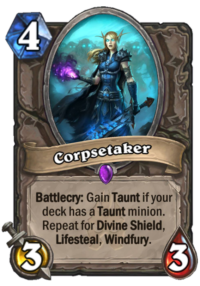
When you play vs Aggro, keeping board control is your #1 priority at all times. You don’t try to race them, unless you really get ahead in the mid game with something like Corpsetaker + Blessing of Kings. Most of the time, you want to keep the board clear as well as you can.
Try to play on the curve, and plan your curve ahead. Floated mana (the mana you’re not spending at the end of the turn) is wasted mana, and that can often be prevented with clever planning, as well as the use of Coin. The latter is really important. Keep in mind that you will always have a way to fill one mana with Hero Power. So let’s say that if you’re on Turn 3 with Coin, you have a 2-drop and a 4-drop in your hand, playing Coin + 4-drop is a higher tempo move, but then you will have to play a 2-drop + Hero Power next turn, meaning that you end up with the same two plays over two turns, but now you’re down a Coin and you float one mana on T4. Sometimes you will have to do that anyway, but unless it’s absolutely necessary, try not to.
Buffs are a big part of your deck. They’re an amazing way to gain some tempo. Let’s say that you have a 1/1 on the board, against a 3/3 your opponent has just played. Playing Blessing of Kings not only lets you trade into it, but you still have a 5/2 left, ready for another trade. Spikeridged Steed is even better – not only it lets a small minion trade into a bigger one, but it also makes it much harder to kill AND creates a 2/6 Taunt on the minion’s death. You always want to use your buffs on a minion that can attack. This way you will get some value out of them immediately, EVEN if opponent Silences it. Kings is not that vulnerable against Silence (assuming you use it the way you should), but Steed really is. Corpsetaker is the best buff target, but if you suspect that your opponent might have a Silence, you want to buff another minion instead. This way you spread you value over multiple minions, so Silencing one of them won’t be as devastating (if buffs gets Silenced, you still have Corpsetaker with all of the keywords, and vice versa).
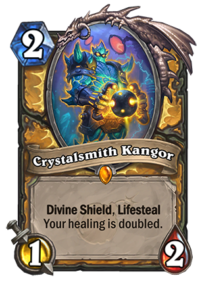
That said, Crystalsmith Kangor is a great buff target whenever you want to heal up. He has Lifesteal, and doubles all of your healing, which means that buffing him with Kings and attacking heals you for 10. Talking about Kangor, he also doubles the healing from Truesilver Champion (from 2 to 4), which is quite meaningful in Aggro games. If you happen to have a Corpsetaker with Lifesteal on the board before drawing Kangor, it’s a good time to drop him if you need some extra healing. If the minion happens to have Windfury too, then you will heal up for 12.
The longer the game goes, the more it favors you in general. You should have a better mid/late game, with cards like Spikeridged Steed, Sunkeeper Tarim, Bonemare, The Lich King or Tirion Fordring. With a few ways to heal up, you should also be able to escape the burn range quite well. If you’re ahead, you should play safe, there’s no reason to take any unnecessary risks.
Vs Control
Games vs Control decks are generally harder than those vs Aggro. Even Paladin is an incredibly board-oriented deck, and without Call to Arms, it now has limited ways of refilling the board. While you should be able to refill it after the first AoE, maybe even the second, it might get harder after that.
Even Paladin is a Midrange deck, so while it tries to take a Control role vs Aggro, it also takes the aggressive role vs Control. You want to go in quickly and don’t drag the game out too long. Your deck is at its strongest around Turn 4-6, and you want to utilize that and try to deal as much damage to your opponent as you can.

However, it doesn’t mean that your early plays aren’t important. Early Hero Powers, as well as your 2-drops, are amazing, because they will either stick to the board and deal chip damage to your opponent every turn, or he will be forced to use some of his precious resources to deal with them. For example, if T1 Hero Power, T2 2-drop, T3 Hero Power + 2-drop forces an AoE out of your opponent, it’s not bad at all. Of course, you’d rather have those minions stick, but it’s one AoE down for the mid game. One thing to consider, though, is that Argent Protector has a really good late game scaling vs slower decks. It’s always a 2/2, but putting Divine Shield on a bigger minion might save it from removal. Of course, it depends on the matchup (Divine Shield does nothing vs Hex or Vilespine Slayer, for example), but it can be really good vs some removals like Shield Slam or Warlock’s Spellstone.
However, your 4 mana plays are much more important, as they’re the ones starting to put pressure. You have three main options. Corpsetaker is generally the best one assuming you didn’t draw the cards you pull keywords from. While you don’t need Taunt or Lifesteal vs Control, having Divine Shield and Windfury is important. Divine Shield should be easy, as there are 3 different sources that give you it, but Windfury is only provided by Windfury Harpy. Of course, you can still win without it, but it will be harder. Actually, dropping Windfury Harpy on T6 can also be a better play than one might expect. If your opponent turns out to not have a removal for it, buffing it or even just attacking for 8 can quickly close out the game. You might even use it as a way to bait out a Silence before playing Spikeridged Steed (because if your opponent can’t kill it, he will probably try to Silence it instead).
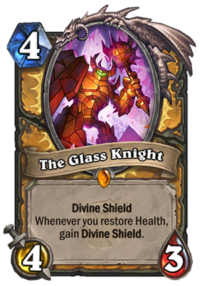
Your second best T4 play is The Glass Knight. Divine Shield is really meaningful on that minion – it doesn’t matter that it only has 3 health if your opponent can’t kill it. It survives most of the early removals and AoEs, which is great. Whenever you gain health, you restore the Divine Shield, which is something you want to utilize if you can. For example, after you trade into it, or when it loses it because of an AoE damage, the easiest way to get it back is Truesilver Champion. Swinging with it should restore it. A big harder way to do it is through Lifesteal minions, such as Corpsetaker or Crystalsmith Kangor. A bit harder mostly because you can’t attack with them immediately. Keep in mind, however, that you need to be damaged in order to trigger that. You can’t restore health when you’re already at 30. Which means that sometimes your opponent damaging you is actually good for you. And that’s also the reason why Truesilver is the best card to do it, since you can also take some damage first (by attacking a minion) and then restore Divine Shield with the second swing. Either way, if you get a Divine Shield train going on The Glass Knight, it can really win you the game.
Your third best Turn 4 play is a simple Blessing of Kings. Ideally, you want to play it on a Divine Shield minion or Windfury minion, preferably both. That’s why one of the common ways to close out the game is playing Corpsetaker on T4 (or T3 with Coin) and then buffing him with BoK next turn. If your opponent has no Silence (or Big Game Hunter, actually), it will be very hard to clear. The Glass Knight is also a great buff target, especially if you also have a way to restore his Shield. But to be completely fair, any minion will do. Even turning a 1/1 into a 5/5 and attacking with it immediately is a solid play. 5/5 isn’t always easy to clear so early (as proven by the power of an early trigger on Devilsaur Egg), and adding 4 immediate damage puts a nice pressure on your opponent.
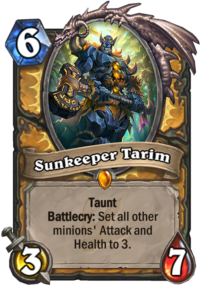
Sunkeeper Tarim is another MVP in slow matchups. Most of the time, you should have more minions on the board than your opponent. On average, your minions will also be smaller than the ones from your opponent. If you add those two facts together, it’s easy to see why Tarim is so amazing. There are two main ways of using him. The first one is to deal with a bigger threat. Let’s say that you face an Even Warlock, who just dropped a Mountain Giant, or just any deck with The Lich King. By turning it into a 3/3, you can clear it quite easily, even with a 1/1 (who you’re also turning into a 3/3). You pay 6 mana to deal with a big threat at the cost of your small minion, put a 3/7 Taunt on the board, and probably even buff some other of your minions. The other use is just as a board-wide buff. If you have a bunch of 1/1’s, 1/2’s, 2/2’s etc. (basically, minions that are smaller than 3/3), turning them all into 3/3’s is a big play. It’s also a great way to deal some unexpected damage. A board with 3x 1/1 + a 2/2 would deal 5 damage, but a board with 4x 3/3 will suddenly deal 12, and it will also be much harder to remove (e.g. will no longer be in the Defile range).
Your 8 mana plays should be seen as game finishers. Bonemare is the most aggressive one – you immediately push 4 extra damage and end up with 2 big minions on the board (whatever you’re buffed + a 5/5), forcing your opponent to play a big AoE (like Twisting Nether) or two single target removals, which can be kind of difficult. The Lich King is a slower play, but 8/8 body is still significant. The random cards you’re getting vary from nearly useless (Doom Pact), through situationally okay (Death Grip, Army of the Dead) up to amazing in most of the scenarios (Frostmourne, Death and Decay). Tirion Fordring is something in between. It’s not as aggressive as Bonemare, but also faster than The Lich King. It’s harder to kill because of the Divine Shield, and it gives you an amazing weapon on death. 5/3 means 15 damage, if your opponent doesn’t have a way to remove it, you will often win the game. However, it’s also very vulnerable to Silence OR removal + weapon removal. All three plays, however, are great in slower matchups.
Paladin isn’t known for its ability burst – most of the damage you do will have to be done with minions. However, there are still a few ways to push some extra damage even if your board is constantly getting removed. One of them is Avenging Wrath. Against slow decks you will often want to use it on the empty board. Dealing 8 damage for 6 mana is amazing for Paladin, if you also have some minions pressure, it might be enough to set up next turn lethal. Another way to deal damage without using minions are obviously weapons. Truesilver Champion is pretty solid, it pushes 8 damage over two turns. However, the best two weapons you can get are 5/3 from Tirion (Ashbringer) and Lich King (Frostmourne). 15 damage over 3 turns is amazing, and the second one gets an extra value if you clear minions with it (you still want to go face if your opponent is pretty low, but if he’s not, it might be a great way to get the final board refill). There’s also Consecration – it’s only 2 damage for 4 mana, but it might come handy if you nearly got lethal and your opponent has Taunted up.
Card Replacements
Even Paladin is a pretty expensive deck and sadly some of the cards simply can’t be replaced. I’ll still try to go through the list and offer some potential replacements wherever it’s possible. Keep in mind, though, that the more cards you will replace, the worse the deck will get. Replacing 2-3 cards can still leave you with a solid build, replacing most of them will probably give you a pretty bad deck.
- Crystalsmith Kangor – It’s your source of Lifesteal in Corpsetaker, as well as a way to get some burst healing vs Aggro. You can replace it with Vicious Scalehide, but it will be significantly worse.
- The Glass Knight – Great threat vs Control, since it’s very hard to kill. It needs to get Silenced and then cleared, or removed two times during a single turn, or else your opponent risks you renewing its Divine Shield. Very good card in the deck, but it can be replaced with Saronite Chain Gang or Argent Commander.
- Genn Greymane – It’s the only reason you play the deck as Even, you obviously can’t replace it.
- Sunkeeper Tarim – MVP of the deck in many matchups, Sunkeeper Tarim is going to win you LOTS of games. You still can play the deck without it, but it will be much worse. Since there is no direct replacement for the card, you can try a second Spellbreaker or Argent Commander instead.
- The Lich King – A great late game value tool, useful in most of the decks. Nearly everyone should have him at this point, but if you don’t have for some reason, you can try a second Bonemare instead.
- Tirion Fordring – Similarly to The Lich King, but instead of being a value tool, it’s more of a good tempo play (unless Silenced). If you don’t have it, again, Bonemare is the best replacement. If you already play two, however, use any of the replacements listed under other cards.
- Corpsetaker – Corpsetaker is amazing in this deck, it’s basically built around it. Right now the Corpsetaker builds are the best (and only, to be honest) Even Paladin builds. I don’t recommend playing without them, but if you want, you’d have to change some other cards too (e.g. you don’t need Windfury Harpy, or Lifesteal).
- Avenging Wrath – Some builds run one, but I like using two. It’s an okay board clear vs Aggro and a very good finisher vs slower decks. Mossy Horror is a replacement you can use, but it’s also an Epic. Alternatively, try Argent Commander.
Leave a Reply
You must be logged in to post a comment.





Is Chillblade Champion viable in this deck? I’m looking for a little more tempo, thinking about swapping this with the Argent Commander I currently run.
Is it worth running valanry in this deck and what should I replace for it.
Sure you can! You have some techcards you can change i guess. I run Chaingang, cause of my Valanyr. If it triggers and you have them in hand you may have two of them cicling through your Hands minions. I also run one Dinosize, cause if any of your 3 windfury minions survive you can make a huge damage turn. You also can put Dinosize on Kangor.
For your question: you can replace Tirion for Valanyr. Cause you lose Tempo and Maybe value if you Play him alone, or if he gets silenced. You can also change one Avenging Wrath into Valanyr. Or also one Argent Protector. There are more ways. Just find out how your meta goes in your ranks. Pyromancer is nessecary i guess, for any big clears with Equality. So your ways to change some card for Valanyr: Tirion, Spellbraker (maybe), Argent Protector, Avenging Wrath. But remember, all of them are really good Cards. You can keep Tirion too and replace any other of them. The other like 20 Cards are a big deal and you dont want to change them like windfury Harpy (only for Corpsetaker in this deck), if you dont have Kangor put in Scalehide for lifesteal.
Hope i helped you.
Good explanation, those are the cards I would replace for Val’anyr too 🙂
And yeah, if you’re running Val’anyr, adding Saronite Chain Gang is a good idea. Those two have great synergy!